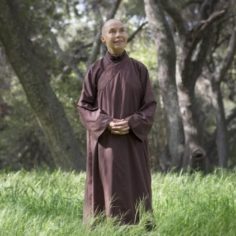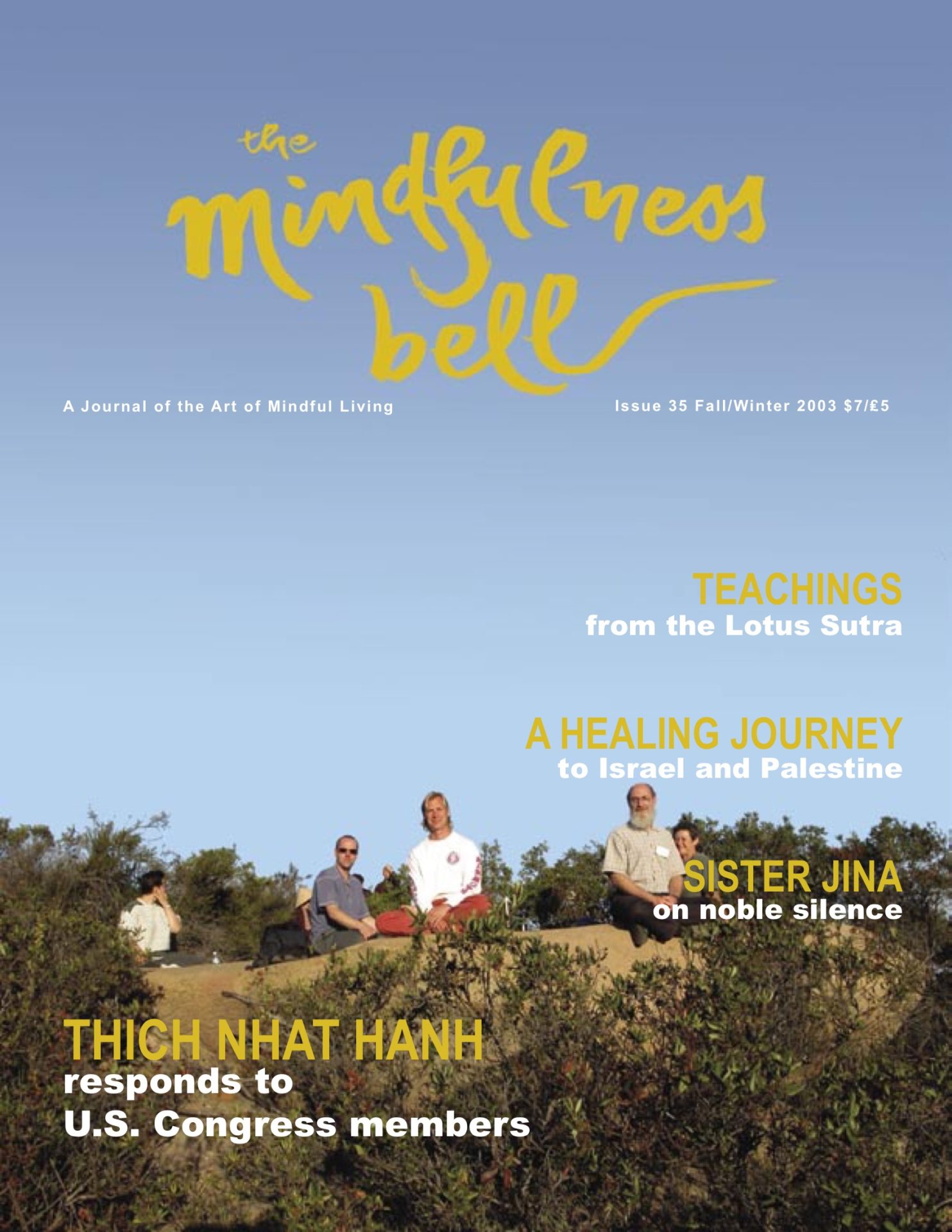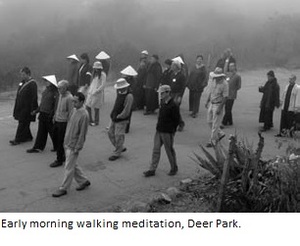
A Dharma talk given by Sister Jina on September 1, 2002 in the Upper Hamlet in Plum Village
I have been aware of silence this week. I would like to share with you a little bit how I practice with noble silence in my daily life. I first came to Plum Village in 1990 for the first twenty-one day retreat in June. We were advised to observe silence on lazy days.

A Dharma talk given by Sister Jina on September 1, 2002 in the Upper Hamlet in Plum Village
I have been aware of silence this week. I would like to share with you a little bit how I practice with noble silence in my daily life. I first came to Plum Village in 1990 for the first twenty-one day retreat in June. We were advised to observe silence on lazy days. So the first lazy day I went out to have breakfast on the veranda in the Lower Hamlet and someone came to sit next to me and said, “Oh, this may be a good opportunity to talk to you.” And at the table next to us there were three other friends and they were talking. And all of these friends had been to Plum Village before and I did not know what to make of this. For the rest of the retreat I do not remember silence being mentioned at all. We did not have a silent period on the schedule. I stayed for the Summer Opening in the Lower Hamlet. All the Vietnamese speaking friends were in the Lower Hamlet and just a handful of non-Vietnamese speaking friends. The Summer Opening was a very joyful event and we were not very silent. I have kept the schedules of our retreats over the years and it was in 1992 that the word silence appeared on the schedule, “lights out, silence.” And in 1993 we started to call it “noble silence.”
Nowadays we have a period of silence on our schedule that starts at nine p.m. until after breakfast and sometimes we like to extend it until after lunch. Noble silence does not mean that we are not allowed to talk. It means that we don’t have to talk, we have no obligation to talk during that period of the day. It makes a difference in how we practice. I would like to thank Thay Doji for sharing how he observes the noble silence. It is a good reminder for me to know when I am approached by someone that I can ask, “Do you have to say this now? Can it wait until later?” Also when I am about to approach someone I can ask myself, Do I have to say this now, or can it wait until later? What makes silence noble is that it becomes an inner silence. The mind is calm and at ease. Whenever I hear the sound of a bell, whether it is the outside bell or the telephone or the chiming of the clock, I take it as an opportunity to practice noble silence. First I go back to my breathing. I feel the air moving in and out of my body. I become aware of the sensation moving into the body, the temperature of the air and the substance of the air when it moves in and when it moves out. Having come back to myself like that I become aware of the feeling that is present whether it is pleasant, unpleasant or neutral and the mental formation that is present. I am nourished by a pleasant feeling. When we have a neutral feeling we have means of turning it into a pleasant feeling. When the feeling is neutral as it is now, I can feel it is wonderful just to be here not being overwhelmed by an unpleasant feeling and already the neutral feeling becomes a pleasant feeling. When an unpleasant feeling is present I can bring to mind that it is impermanent and in a little while it will no longer be there. That calms down the negative mental formation.
We often speak about embracing mental formations. When I feel the impermanence of a mental formation I can stay with it because I know that just by staying with it without doing anything else it will take its course and eventually it will disappear. But often I also take care of the mental formation by finding its manifestation in my body. The mind and the body are one so if there is a strong mental formation present in the mind it is also present in the body. So I become aware of my body and I ask the question: where does this mental formation, this emotion manifest itself in my body? Sometimes it is in my throat, like tightness, sometimes it is in my abdomen, like having a knot, or in the solar plexus, or in my neck or it is butterflies in my stomach. I find out where this mental formation of emotion manifests in my body. Breathing in, I become aware of where it is located and what it feels like, and breathing out, I relax. I find in that way I calm the mental formation that is manifested in my body and at the same time I calm it in my mind. With the practice of stopping and listening to the sound of the bell I go a little bit in the direction of inner silence. Now let’s listen to the sound of the bell and practice this.
Bell…
I found some tension in my shoulders and I realized that I am carrying the responsibility of what I am going to tell you. So I relax. The practice of total relaxation is very refreshing for our body and our mind. It is something that I practice every evening before going to sleep. When I am in bed I take my cassette recorder and I take a tape—very often it is a chanting tape. It can be one of our own chanting tapes, or Christian chanting or any other chanting that I find pleasant. I make myself comfortable and I listen to the chant. Rather, I open myself and let the chant come in. I receive the chant. I receive the chant and I become aware of my body and whenever and wherever I find tension in the body on the out breath I let go of the tension. While doing this I am aware of my body weight increasing. I am getting heavier and heavier. Every time I let go of some tension I notice that that part of my body gets heavier. It is a sinking feeling as if I am sinking into the mattress or onto the bedboard until I come to a place of rest and then the body is very calm and quiet and so is my mind. The cassette turns itself off and I kind of sleepily take the headphones off. In the morning my mind feels very refreshed and light and so does my mind. The body moves around very lightly and gently.
I have noticed that when the mind is busy my body is also busy and I tend to be noisy. I put things down and it makes a noise and I move things around and it makes a noise and sometimes I bump into things. I like to regard my body as a door to come to this inner silence. I become aware of the sounds that I make when I move around. If it is very noisy I just focus on doing everything quietly. This has a wonderful effect: I become quiet and my mind quiets down too. It is logical because I am bringing the mind and the body together and that is when we have peace and calm. We are practicing mindfulness.
The other day I was sharing with some friends about my time as a novice in a mountain temple in Japan. When I went to a practicing temple in Japan for the first time I was given an outfit, a kind of temple dress. And I was given stiff slippers. The temple was large with wooden floors and we had to walk a long way from the Buddha Hall to our bedrooms and to the dining hall. We were told not to make any noise while walking. You couldn’t make the sounds, “patter, patter, flip-flop.” And that was quite difficult with those stiff slippers on those very shiny wooden floors. You have to be very mindful to walk without making a noise. And further we had to be pretty quick. And we were asked not to make a breeze. So we had these long robes that would flap as we walked but we had to find a way that they wouldn’t flap, wouldn’t make a noise and they wouldn’t cause a wind. We had young monks pointing out to us every time we made a noise and would make our robes flap. They reminded us in a kind of teasing, joyful way. But it brought us to being more mindful while moving about.
Also when practicing sitting meditation I find body awareness very centering and stabilizing. When we sit on a cushion sometimes we don’t really sit. If you bring your awareness to the lower part of your body you may feel that you are not really sitting. We are almost off the cushion. So when I sit on the cushion I become aware of the contact that I have with the cushion and I become aware of the feeling that is in my body. Every time I breathe in I become aware of my body and when I breathe out I let go of any tension I may find in my body. In that process I find that I am slowly, slowly landing on my cushion until in the end I sit on the cushion. This is what I do at the beginning of the sitting meditation to really arrive on my cushion. It is very pleasant.
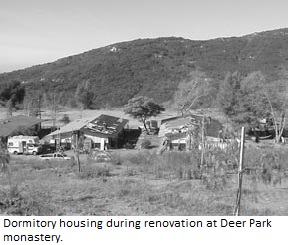
The tension that I find is often somewhere in my head, on my face or in my shoulders. When the shoulders are tensed I am not really on my cushion. So I relax my shoulders and I already arrive a bit more. Another place I may find tension is in my lower abdomen. I relax my lower abdomen and I have that sinking feeling of arriving on my cushion. There are times when I keep this body awareness for the whole period of sitting. I am aware of the whole body as a single unit. What I mean is that I become aware of my whole body. I start at my head and I let my mindfulness flow throughout my whole body until every nook and crook is filled with my awareness. That is when the body and mind are one. I practice keeping this awareness of the whole body throughout the whole period of sitting. This brings about a joy in the body. It feels as if every cell of the body is happy. There is a slight tingling sensation throughout my whole body. It is very nourishing to practice sitting like that.
Being aware of my whole body quite naturally helps me to be aware of my breathing because breathing is something that happens in the body. This gentle flow of breathing in and out is something that I naturally become aware of when I become aware of the whole body. Maybe we can try that. Start from your head and let your awareness spread out throughout your whole body.
When we do slow walking in the meditation hall I like to walk with my palms joined and I like to be aware of the quality of touch between my palms. It is a gentle touch, but it is firm. Also I am aware of where I hold my palms. There is a place where I hold my palms that doesn’t cost me any muscular effort. You can try. Sometimes when they are a little bit lower it feels like they are being pulled down and then if I pull them up they feel weightless with no effort whatsoever. Then I walk and I become aware of my body moving through space. Every time I put my foot down I become aware of the contact between my foot and the floor. I like to become aware of the weight of my foot on the floor and come to rest in the steps. When I put my foot down there is a little pause when I rest, I sink into the step. There is also a physical feeling I have of sinking into the step. I sink into every step. It is very pleasant. I also like to practice that outside, but not so slowly. At times to rest in each step can be very challenging. For instance when the activity bell has already been invited there is a sense that I have to hurry. When we walk in a hurried way we don’t rest in every step. Instead, we seem to quickly touch the earth in order to get somewhere. So I practice taking the hurry out of my steps so that I can come to rest in every step. It is a bit tricky because there is something in me that tells me if you don’t hurry you will be late. But I also experience that if I don’t hurry I will get there much faster because the hurry comes from the worry and the worry is very heavy and slows me down. If I drop the hurry and the worry I can move a bit quicker and be in every step and be on time. You can try, it is very interesting to experiment with that. You can meet this habit energy that says you have to hurry or you will be late. You can move faster but you don’t need to hurry. It is very handy when you are at the airport and a bit late.
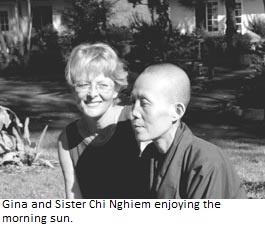
I use body awareness a lot to come to inner silence. I find it important, every day, to do some learning or studying, some reflecting and then practice. The time for reflecting is very precious for me. The time for learning is when we hear teachings, or hear the sutras or read a book. And then we have some time to reflect, to see where we are in our practice and what steps we are going to take in our practice and then we put it into practice. In the sutra, Knowing the Better Way to Live Alone it says not to be carried away by how our bodies, feelings, mental formations etcetera will be in the future. When we have read that sutra in the morning I take some time during the day to note when I let myself be carried away by thoughts about the future and I do catch myself, for instance, writing scenarios. I am thinking about having to tell somebody something, which is going to happen in the future, and in my head I write a whole scenario. I write my role of what I am going to say and then my sister’s role of what she will answer and then what I will say. I have it all written down. But my experience is that this scenario is never going to be realized, it is just something that I do in my mind. If I get caught in it then when I meet the sister I experience our whole meeting through the veil of this scenario and I react on my scenario and I don’t really act in an appropriate way to what is happening. When I find myself writing scenarios I practice dismissing it. I say this is a scenario and it may not happen at all. My experience says that it is not going to happen like this, so why do I believe in this scenario? So I can drop it and go and see my sister and see more clearly what is actually happening between the two of us. Hearing what my sister says and hearing what I am saying makes our encounter more fruitful. When I find myself trying to rewrite history, wanting it to be different—something has happened and I am going over it again and again, wishing that I have not not said or done this or he or she had not said or done that—I find that it does not help. When I notice I am doing that I practice dismissing and letting go of that habit energy and I try to look at what happened in order to get some understanding, in order to learn something from it. I take a teaching by Thay or a sutra to help me look. At times I take the Discourse on Love that speaks of loving and protecting all beings as a mother loves and protects her only child and I see in some situations I have not had that kind of mind at all. Or I take the Sutra on Reflecting and Measuring. Someone has told me something and I have answered back, not listened and just accepted it, so I can see what my contribution is to the situation and I determine to do better. Of course this doesn’t happen straightaway, it takes some time.
When I was in Japan there was a clear example of that. At the temple where I practiced in Japan we were only six or seven people. The practice leader was also the work coordinator because work is practice. My brother who was the practice leader had the habit of telling me what to do, which I experienced as being bossed around. He would come at any time of the day and he would say, “Jina-san, the toilets are dirty—go and clean them,” or “The meditation hall is dirty—go and clean it,” and I would always react in the same way. I would say, “Why do I have to do that? You always ask me to go and do these things.” And his answer would always be, “Because it is dirty and it needs to be cleaned.”
One day after chanting, something in the chant made me reflect on my habit energy. I was sitting in my room and remembering the previous day when this type of incident had happened and I looked at why I would do that. I saw that my brother had a good heart and was very committed to the practice and to our living together and he wanted to keep things neat and tidy. In fact, for me it was the same—I like to keep things neat and tidy. So we both want the same thing, but why did I always react like that? Inside of me was a little ego, or a big ego. What if my master came and said, “Jina-san the bathroom is dirty would you mind cleaning it?” I would bow and say, “Yes, master,” and I would fly so happily because the master had asked me to do something. But the fact was that the bathroom was dirty and it needed to be cleaned all the same. So I realized that something in me would like to be asked by a special person in a special way and then I would very happily do it. So I decided next time and any other time when my brother asked me to do something I would just bow and say, “Yes, brother,” and I would smile and go do it.
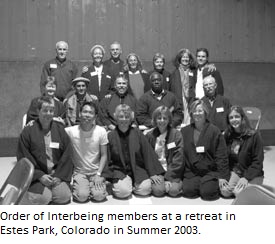
A few days later I was in the Buddha hall and my brother came up to me and said, “Jina-san, the bathroom has not yet been cleaned, so go and do it.” And I said, “Why do I have to go do it? You always ask me to do things.” And then he answered, “Okay, you don’t need to do it.” And that brought me back to my resolution and I said, “No, brother, you know I always react like that. It is just a habit. But you also know that usually I go and do it. So never mind my reaction I will go and do it.” And he said, “Okay.” From that day on it became a joke between the two of us and my brother would come and say, “Jina-san, go and clean.” And I would bow and say, “Yes, brother.” And sometimes he would ask me in a friendly way and at other times he was grumpy. I would think sometimes I am grumpy too, and I would just smile and go and clean.
We make a resolution about our habit energies or how we contribute to a situation and then we decide what we would like to change, what steps we will take and how we will practice. For me it is important to do that everyday. I take time to do that.
Thay once advised us to write our own sutras, so I did. I wrote a sutra about practices that would help me to listen and would help me to live in harmony with my community. Listening requires a silence, an outer silence and an inner silence to be able to hear what is being said and also what is not being said. Deep listening is an expression of inner silence. I use the practice of listening in order to cultivate inner silence. I read my sutra everyday. I usually do it in my hut. I go and light incense and I sit down. I face my little altar and I read my sutra aloud, slowly. I allow every sentence to sink in to water the seeds of awareness of the practice in me. It really helps me in my daily practice when occasions arise where I need to practice what I have decided to practice. A sentence out of my sutra spontaneously comes up and it helps me to practice. There are also times where it doesn’t come up and I notice afterwards and I take some time during the day to read my sutra again or if I know it by heart I will go and sit somewhere quietly and mentally go over it again. It really helps me. I find great joy in practicing and progress in the practice motivates me to continue. I would like to read my sutra to you. It is my sutra right now. When I feel I have realized enough of my sutra then I add other things. I take another aspect of the practice that I would like to strengthen. On top I have written ”Listen” because I would like to practice listening better.
The training in the art of listening begins in silence, develops in attentiveness and is perfected in communication.
This is something I read somewhere and it makes sense to me. It gives me a good guideline for practicing listening in daily life.
I will practice refraining from saying something that lies on the tip of my tongue.
Just by reading this every day I become aware of what lies on the tip of my tongue and I realize that often I am not aware of what was there on the tip of my tongue and I say it out before I realize what I am going to say. Keeping something on the tip of my tongue, I really have the opportunity to taste what it is like. It is not always sweet. It gives me some insight into my mind, my mental formations and the strength of the seeds in my store consciousness.
I shall listen to others’ points of view before stating my own.
This ties into what lies on the tip of my tongue. This practice is very important when we want to come to consensus in a community or in a meeting. I have written this here because sometimes when I am tired in a meeting I just state my point of view and then I think that is enough, let’s just finish the meeting and I don’t really create much space for other people to state their point of view. That is not very beneficial. I have found that when I wait for others to give their input I don’t need to give my input or I do it in a different way that is more beneficial for a meeting. That is one point I am practicing with right now.
I will practice not speaking about a third person.
In a community it is easy to speak about a third person and it can cause a lot of disharmony and suffering. We can speak about a third person on occasion in the light of how we can help that person in the practice. I am certainly not perfect at any of these points, that is why they are still here in my sutra, but I am becoming more and more aware of when I speak about a third person and how. When we are discussing the practice of a third person I become aware of any internal formations I may have regarding that person or the practice of that person. I can take care of my internal formation and try not to let it interfere with the input I give on the practice of that person.
If met with anger I shall respond with loving-kindness.
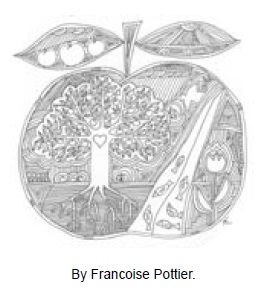
The Buddha said that the antidote to anger is loving-kindness. I try to keep love alive in my heart. We all know that meeting anger with anger is not beneficial but we know that we get pulled into it anyway. Reading this every day helps me to remember to look with loving-kindness at myself and at the other.
If met with non-cooperation I shall respond with compassion.
For those of us who live in the community or at home in a family we know that there are times when things need to be taken care of and at times we are met with non-cooperation of other members of the community. I am practicing responding to this with compassion. I try to put myself in the skin of the other to try to understand where the non-cooperation comes from. I try to discern when and how to encourage and when and how to release or let go.
The sound of the bell allows me to enjoy the whole length of my in-breath and the whole length of my out-breath.
I know this is our practice but I find it necessary to be reminded of that every day. Being aware of the whole length of my in-breath and out-breath allows me to be aware of what is happening inside of me. There are times when I just find myself waiting. The bell is invited and I stop but I am just waiting for the bell to stop so I can continue with whatever I was doing. Reading this reminds me that it is nice to take the opportunity to enjoy the whole length of my in-breath and the whole length of my out-breath. When I find myself waiting it is usually when everyone starts moving around that I realize I have just been waiting. I think I missed the opportunity but I can do it here. I can take a few moments to enjoy my in-breath and out-breath.
Every step brings me peace and joy.
We know this and we practice this in theory. At least, I practice it in theory. But I want to practice it in reality, so reading it every day helps me to do so.
Then I close with some words by Saint Benedict which help me to put things in the right perspective.
In the end it is not about what we have achieved but what we have become.
I would like to realize my full potential and reading my sutra every day helps me to go in that direction. This practice of learning, reflecting, and putting into practice and my sutra all help me to go in the direction of inner silence. It is an inner silence that I can practice throughout the day. Periods of outer silence can help us to cultivate this inner silence.
In the winter of 1998–1999 in the Lower Hamlet we had one day of the week where we could observe noble silence. We were allowed to put on a little badge that said, “noble silence.” It was mostly retreatants who used the opportunity to do so. I like to do this very much but I need the reassurance of the community that it is okay. I feel an obligation to always be approachable and ready to respond to the needs of the community. A period of noble silence might help me to do so better. An inner silence means nothing else than dwelling in the present moment.
I guess the Buddha wouldn’t have anything against that.
Thank you very much for listening.
Sister Jina is the abbess of the Lower Hamlet at Plum Village in France. Photography by Big Jim.
